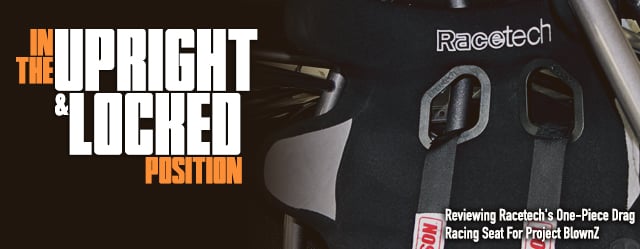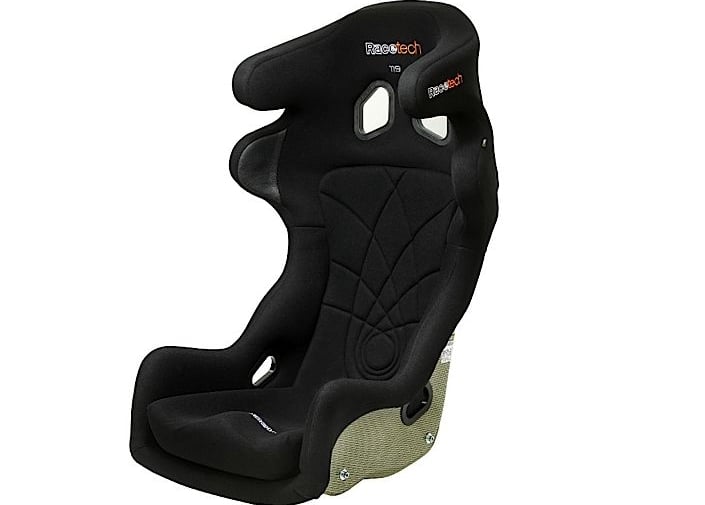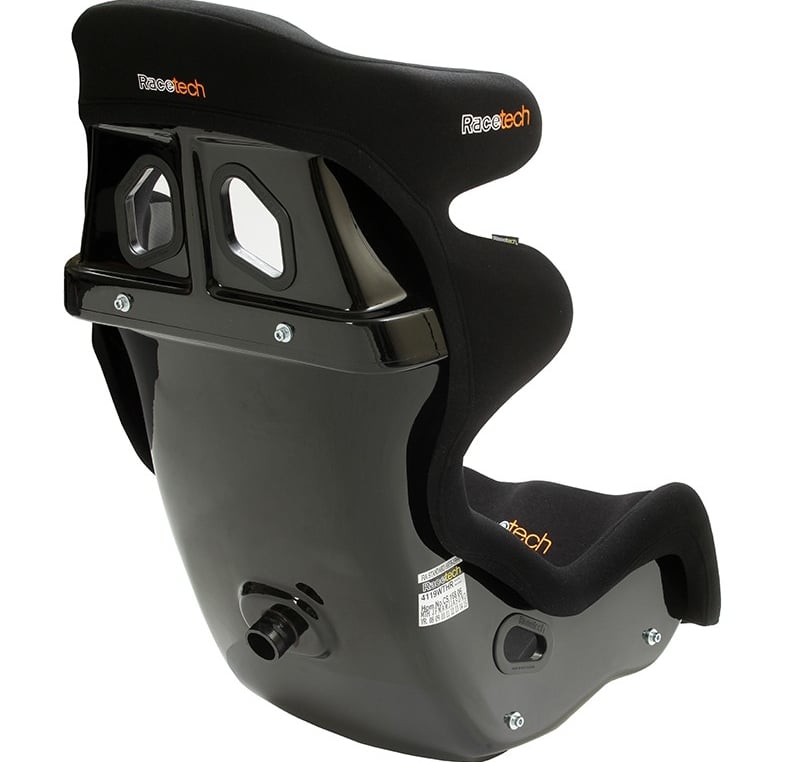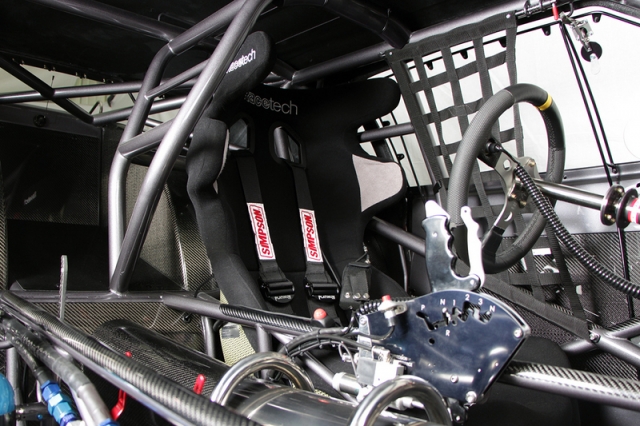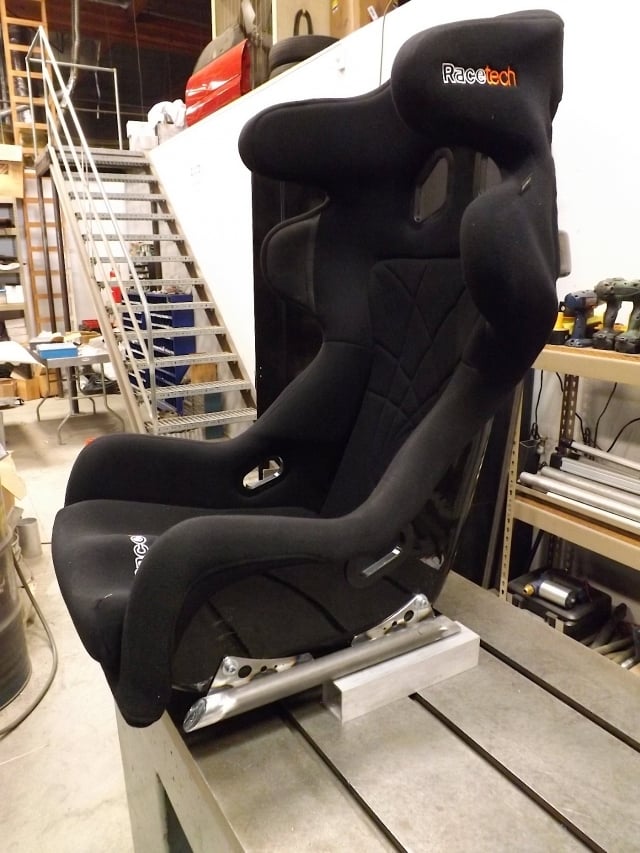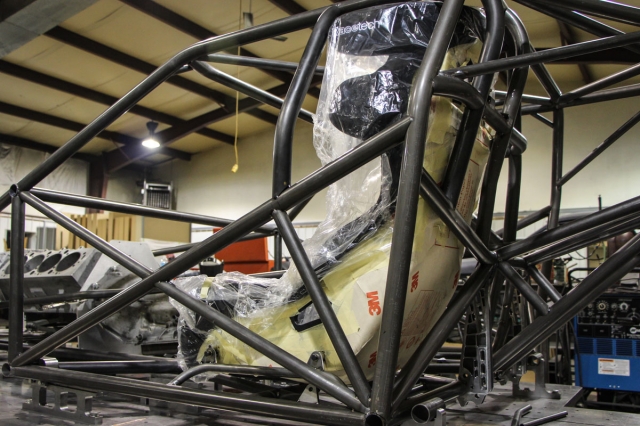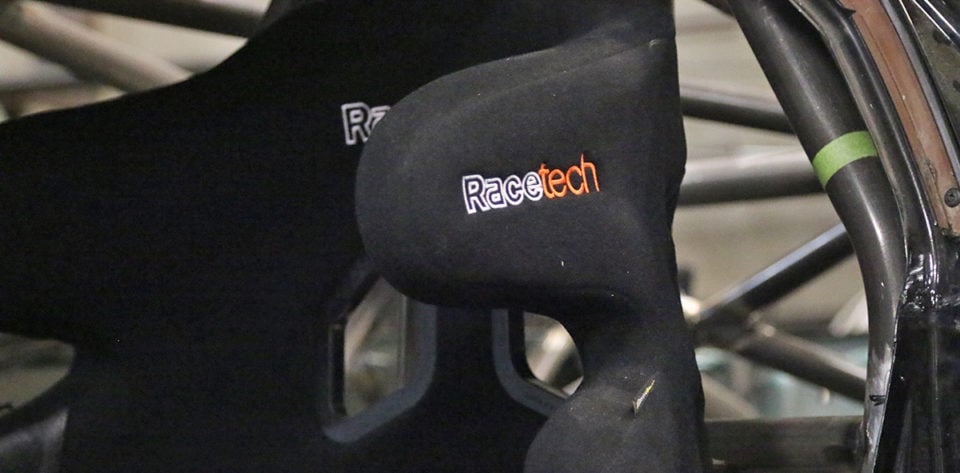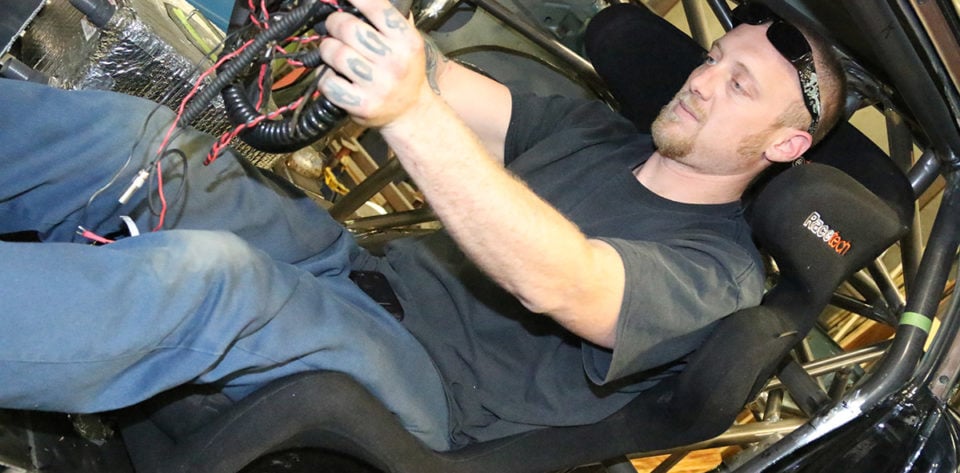In the search of ever-quicker elapsed times in NMCA competition, our drag radial project car Blown Z has undergone some significant changes to the chassis, including a new 25.3 certified chromoly roll cage and LSX engine package this winter. Already a 7.3-second shooter, we’re gunning for low 7-second elapsed times in the quarter mile at over 190 mph with the car this season, on a 275 drag radial tire, so driver safety is of the utmost concern.
Since we’re making significant updates to the car, we thought it was a perfect time to address the safety side of things, namely the driver’s seat and surrounding area. Through some excellent references, we turned to the team at Racetech USA to get one of their ultra-cool kevlar/carbon fiber seats for our ride. Not only is this seat surprisingly lightweight, its one-piece construction makes it incredibly strong.
The Racetech seat is shown above with the integrated upper torso and head supports built into the one-piece construction of the seat. The detail seat cushion can also be seen within the photo, which is made from fire-retardant fabric with energy absorbing foam. The photo on the right illustrates the upper and lower mounting holes that are built into this seat, which simplifies the mounting of the seat since it requires no holes to drill. The seat ventilation tube is also shown in the right photo which allows cool air to be ducted to the seat to keep the driver cool in the staging lanes.
While the aluminum seat that was removed from BlownZ served its purpose, it didn’t offer much protection in terms of energy absorption in the event of a crash. Within this story we will explain the technical benefits of Racetech’s Kevlar/Carbon-Fiber seat and how it could help you walk away from a serious crash should the unthinkable occur.
The Racetech Seat
For this story, we spoke with Brian Oleshak from Racetech USA to understand the technical benefits of their composite seats. Racetech’s stateside office is located in the stock car racing capitol in Mooresville, NC, where seats are sourced for everything from drag racing and stock car applications to road course and rally cars and even street cars and hot rods. We also caught up with leading chassis builder Tim McAmis of Tim McAmis Race Cars to understand why they only use Racetech seats in the Pro Modified and Pro Stock cars that they build at their race shop in Missouri.
According to Oleshak, “There’s a reason no company manufactures an aluminum helmet. Aluminum can’t help to absorb energy in an impact, like a properly designed and manufactured composite helmet can. The same principles transfer to seats, as well.”
We have already updated our project car with fiberglass doors, lexan windows and McAmis 34-inch carbon-fiber mini tubs to save precious weight on Project BlownZ, so a light-weight composite seat seemed like the next logical next step.
Racetech Company Background
When you think of high tech carbon fiber components, New Zealand wouldn’t typically be a country that comes to mind, but this is exactly where you will find Racetech Manufacturing. Working out of a mid-sized shop in Wellington, New Zealand, Racetech is building high tech carbon fiber seats and safety equipment for some of the baddest cars on the planet. In this shop of 15 people, they supply carbon fiber and composite seats for chassis builders like Tim McAmis, along with race teams like BMW road racing, Subaru Rally and the Dodge Viper SRT team. Since the company headquarters is literally half a world away, Racetech has a support office based in the United States to handle technical questions and product orders.
There’s a reason no company manufactures an aluminum helmet. Aluminum can’t help to absorb energy in an impact, like a properly designed and manufactured composite helmet can. The same principles transfer to seats. – Brian Oleshak
Design and Testing of Race Seat
Racetech offers several seat types to accommodate nearly every racing application from a sportsman-class race car to a five-second, 250 mph Pro Modified doorslammer. Even the fiberglass composite seats at the lower end of the price spectrum benefit from Racetech’s knowledge and quality manufacturing techniques. Racetech has years of testing composite seats to some of the most demanding crash tests possible, which enables them to build the lightest and strongest seats possible for racing applications.
Racetech series-129 seats meet the ultra-stringent FIA 8862-2009 specifications, whereas series-119 seats meet the older FIA 8855-1999 specifications. The series-129 seats are heavier than the series-119 seats since it must withstand higher side and frontal impact tests. A carbon fiber/kevlar series-129 seat typically weighs around 22.5 pounds, whereas the series-119 seat weighs 14.1 pounds. That’s a weight difference of 8.4 pounds.
Racetech also allows their customers to choose between fiberglass composite and carbon fiber/kevlar material within the series-129 and series-119 product lines. The shell of a series-119 fiberglass composite seat weighs 16.8 pounds and the carbon-fiber variant weighs in at a feather-light 9.7 pounds.
The Racetech seat is shown mocked-up in our Blown Z prior to final installation. The integrated mounts simplify the installation while providing a clean overall appearance.
Many racers overlook the seat as a potential safety device since it often isn’t given the same consideration as a parachute or fire suppression system, yet if you think about it, the seat has much to do with you walking away from a serious wreck.
Many engineers within the racing and motorsports community believe that the human body can withstand a crash over 100g’s, if properly equipped with the right safety equipment. That safety equipment includes a helmet, head and neck restraint, five-point harness, and a properly designed race seat.
Tim McAmis On Racetech Seats
Tim McAmis Race Cars uses Racetech seats exclusively in the cars they build, believing them to be the safest seats available on the market through their own testing.
“Because the Racetech unit is one piece, it provides full body support where most drag racing seats only focus on the torso,” says McAmis. “It also has built-in lateral head and hip supports as well as SFI approved memory foam. The Carbon/Kevlar construction is exceptionally strong and helps protect the driver from flying debris. Due to these benefits and a proven track record, Racetech is the only seat that we recommend to customers having a car built in-house at TMRC.”
Racetech’s one-piece seat construction also features side supports at the shoulder and helmet level to prevent side movement of the driver in the event of a crash. To illustrate the crash-worthiness of the Racetech seat, take a look at a story we featured on Tim Tindle’s TMRC Pro Mod at the U.S. Nationals last year. Tim was able to walk away from this horrific crash that destroyed his race car, thanks in large part to the seat he was wrapped in.
Racetech seats are designed to comply with FIA certifications which specify that racing seats must utilize energy absorbing foam in the back, side bolsters and head support areas to lessen the g-forces exerted on the driver during a side impact. Since Racetech believes in the philosophy of using the best materials available, they source this energy absorbing foam from a company in the United States. While this isn’t the most cost effective solution for building their seats, it allows them to use the best materials available, which results in a superior final product.
McAmis explains, “We feel this particular seat is the safest one on the market today. TMRC pioneered the use of these seats over eight years ago. They aren’t cheap, but at 250 mph, what would you be comfortable with?”
Installation
The team at PMR Race Cars utilized the integrated mounting points on the Racetech seat when mounting the seat in Blown Z. A chrome-moly lower seat mount was made to tie the seat into the lower tubular frame of the 25.3 chassis. The upper mounting bracket on the Racetech seat is tied into the funny car roll cage that was recently added to our project car. By utilizing the floor and roll cage mounts, we can ensure that the Racetech seat will provide protection for our driver in the event of an accident.
Racetech utilizes a threaded steel plate at the lower seat mounting points as well as the upper back mount. Steel plates are required by FIA standards to ensure the threads cannot be pulled out of the bracket in the event of a side impact.
The Racetech seat is right at home in our new 25.3 chassis with funny car cage. This Kevlar/Carbon seat is incredibly strong, light-weight and aesthetically pleasing.
When driving at speeds approaching 200mph, the last thing you want to question is the safety of your racecar and equipment. Luckily, we won’t have to question the safety of our racecar since we are using the best safety equipment available. With the addition of the 25.3 certified chassis, funny car cage and Racetech composite seat, our Blown Z drag radial car will be ready to break records again in 2014.



